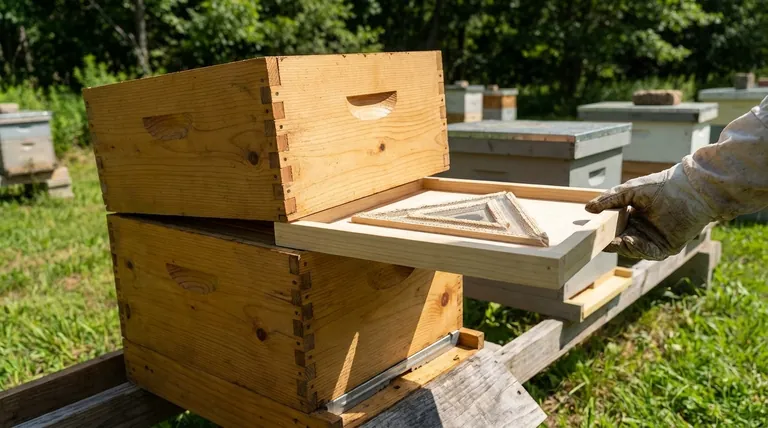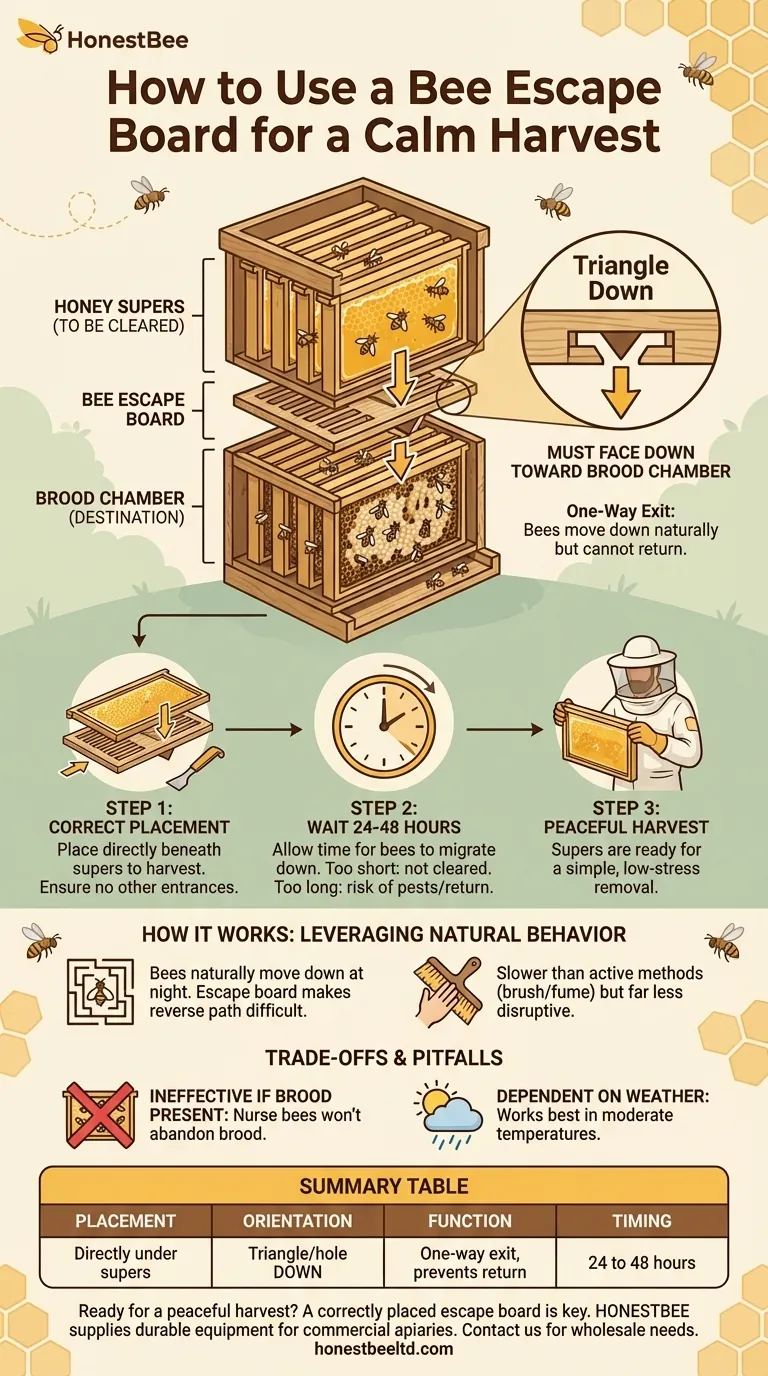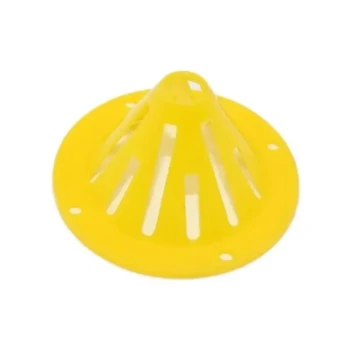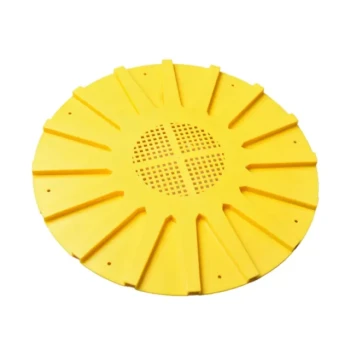To properly use a bee escape board, you must place it directly beneath the honey supers you plan to harvest. The board should be oriented so that the hole or triangle-shaped escape mechanism faces down, pointing toward the brood chamber below. This orientation is critical for the board to function as a one-way exit.
A bee escape board is a passive, one-way gate system for your hive. Correct placement allows bees to move down into the brood box naturally but prevents them from returning, resulting in nearly empty honey supers ready for a calm and simple harvest.

How a Bee Escape Board Works
A bee escape board leverages the natural behavior of honeybees to clear supers with minimal stress. Unlike blowers or fume boards, it works gradually and quietly.
The Principle of the One-Way Exit
The board contains one or more specially designed "escapes" (like the common Porter bee escape or simpler triangle designs). These create a simple maze or a set of weak springs that bees can easily push through on their way down.
However, the design makes it extremely difficult for them to navigate the path in reverse. Bees naturally move down into the brood chamber, especially overnight, to cluster and tend to the queen and brood. The board simply takes advantage of this downward migration.
Why "Triangle Down" is Critical
The exit point of the escape mechanism must always point toward the area you want the bees to move into. Placing the board with the triangle or hole facing down directs the departing bees into the brood box.
If you were to install it upside down, you would trap the bees in the honey supers, completely defeating the purpose of the tool.
Correct Placement in the Hive Stack
The bee escape board acts as a divider. It must be placed between the honey supers you intend to harvest (on top) and the rest of the hive, such as lower supers or the main brood chamber (on the bottom).
Any supers left below the escape board will not be cleared of bees.
The Process: Timing and Preparation
Proper timing is essential for the board to work effectively. It is not an instant solution but a preparatory step for harvest day.
How Long to Leave the Board
Plan to leave the bee escape board on the hive for 24 to 48 hours. Placing it in the morning one day and returning the following afternoon is a typical and effective timeframe.
Leaving it for less than 24 hours may not give enough time for all bees to migrate down. Leaving it for more than 48 hours can lead to problems, as the bees may figure out how to bypass the escape or the remaining honey could be robbed by pests if the seal isn't perfect.
Ensure All Other Entrances are Sealed
The bee escape board will only work if it is the only way for bees to travel between the supers and the brood box. Before installing it, ensure there are no cracks or gaps in your hive bodies that would allow bees to bypass the board.
A small upper entrance or a crack in a box will become a new front door for the bees, rendering the escape board useless.
Understanding the Trade-offs and Pitfalls
While highly effective, the bee escape board is not a perfect solution for every situation. Understanding its limitations is key to a successful harvest.
Slower Than Active Methods
The primary trade-off is time. Using a bee brush to manually clear frames or a fume board to drive bees out is much faster, taking minutes instead of days. However, these active methods are far more disruptive and agitating to the colony.
Ineffective if Brood is Present
The system relies on worker bees wanting to move down to the brood nest. If the queen has laid eggs in the honey supers (a common issue if you don't use a queen excluder), the nurse bees will not abandon the brood. The board will fail to clear these frames.
Dependent on Weather
The process works best in moderate to warm weather when bees are actively moving. During very cool or rainy periods, bees may be more reluctant to move, and the clearing process can take significantly longer.
Making the Right Choice for Your Goal
Use this guidance to decide if and when a bee escape board is the right tool for your harvest.
- If your primary focus is a calm, stress-free harvest: The bee escape board is the ideal tool, as it clears the supers gradually with almost no disturbance to the colony's temperament.
- If your primary focus is speed on harvest day: Consider a fume board or bee brush, but be prepared for a more agitated hive and more intensive physical work.
- If you discover brood in your honey supers: Do not use the escape board. You must first move those frames of brood down into the brood chamber before attempting to clear the remaining honey frames.
By understanding the simple mechanics of the bee escape board, you can ensure a peaceful and efficient harvest that respects the natural behavior of your bees.
Summary Table:
| Key Placement Step | Critical Detail |
|---|---|
| Position | Directly beneath the honey supers to be harvested. |
| Orientation | Escape mechanism (triangle/hole) must face down toward the brood chamber. |
| Function | Creates a one-way exit for bees to leave the supers but not return. |
| Timing | Leave in place for 24 to 48 hours before harvest. |
Ready for a peaceful, efficient honey harvest?
A correctly placed bee escape board is key to a calm, bee-free harvest. HONESTBEE supplies durable, well-designed beekeeping equipment—including reliable bee escape boards—to commercial apiaries and distributors through our wholesale-focused operations.
Let us help you equip your operation for success. Contact our team today to discuss your wholesale supply needs and ensure your next harvest is your smoothest yet.
Visual Guide

Related Products
- HONESTBEE Wooden Bee Escape Board with Triangle Mesh Design for Beekeeping
- Slatted Porter Style Bee Escape for Rapid Hive Clearing
- Heavy Duty Metal Corner Bee Escape for Reliable Hive Clearing
- Circular Labyrinth Bee Escape for Efficient Hive Management
- Durable 16 Way Circular Bee Escape for Efficient Honey Harvesting
People Also Ask
- Where should the triangle escape board be placed in the hive? Master a Gentle, Stress-Free Honey Harvest
- What is the effectiveness of the Bee Escape Board? Achieve a Calm, 95% Bee-Free Honey Harvest
- What precautions should be taken when using the triangle escape board? Master Gentle Honey Harvesting
- What types of bee escape boards are available? Clear Your Supers Fast and Stress-Free
- What are the available frame sizes for Triangular Escape Boards? Find the Perfect Fit for Your Hive



















